What To Do When The Water Runs Out
Water is life, and more precious than liquid gold in a survival situation. Without water, there would be no life on earth, or at least non we would recognize. More than 70% of the surface of the world is covered with water. But only a miniscule amount of that, about 1.2% can be used as drinking water. So what is a person to do when the water runs out? When taps run dry, the prepared will have a have emergency water stored . And the very well prepared will know how to source and purify water.
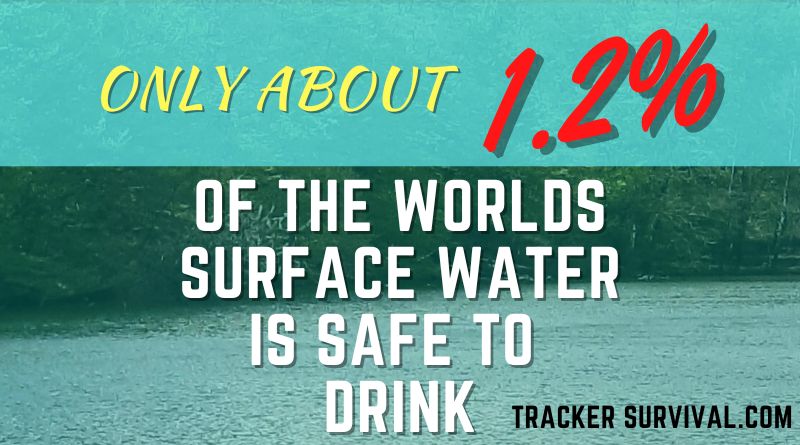
Deadly Water
No matter how desperate you are for a drink of nice cooling water. Any water you find will probably be packed full of bacteria, protozoa, parasites, viruses, and contaminants.
Salmonella, E.Coli, Giardia Lamblia, Legionella, Leptospirosis, Rotavirus, Hepatitis A. Cholera and chemical contaminants. The water may look crystal clear, but that does not mean it is safe for consumption.
Dehydration
In general, a person can only survive 3 days without water. But there are contributing factors to consider that may affect that timeline. Contributing factors such as temperature extremes affect how long before a person dehydrates. Also, a person’s general health greatly affects how much water they need to survive.
Signs of Dehydration
Dark smelly urine, fatigue, lightheadedness, dry mouth, and infrequent urination or constipation.
Lack Of Water
Lack of water can lead to some serious health issues, and in extreme cases death. Common health issues with dehydration are:
Heat-Stroke
Water is also needed to help regulate a person’s body temperature, as a person sweats they keep the internal temperature stable. Lack of water can lead to heat-related injuries
Cramps
Lack of water can lead to an electrolyte imbalance, which can cause muscle weakness or cramps. Drinking water with an electrolyte supplement will quickly alleviate that.
Drink Small Amounts Of Water
To prevent dehydration, take small sips of water throughout the day, whether the urge to drink is there or not.
If dehydration is suspected, rinse the mouth for a few seconds with small sips of water then swallow. Repeat until thirst is slaked.
Do NOT gulp down large quantities of water as the body will find it hard to adjust and there is a chance it may all just come back up.
How Much Water Should A Person Drink Daily?
It depends, as a rule of thumb, men need about 3 liters of water per day and women about 2 liters per day. But this amount can vary if a person is sweating a lot due to weather either hot or cold, exertion, or even a medical condition. More may be required.
This is more than what used to be the generally recommended amount. In the past, it used to be 8 glasses of water a day.
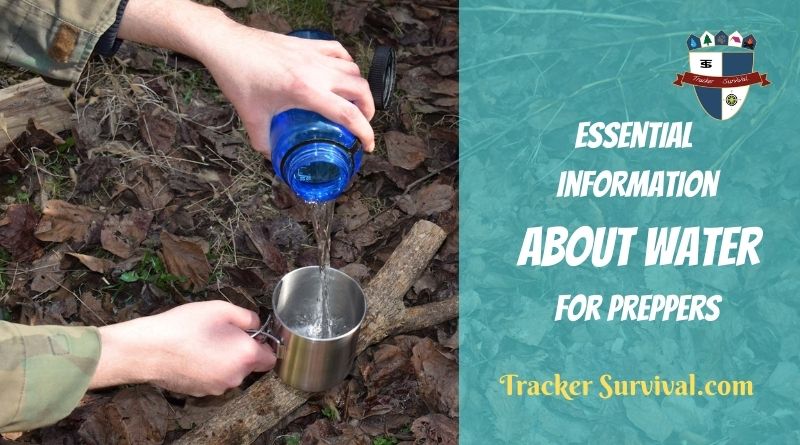
Drinking Water From Unlikely Sources
Tap water, bottled water, river and rain water. When asked what sources of water are out there, these are the answers that immediately pop into mind. Here are a few out of the box places to find water.
Water From Plants
Many plants contain water, such as bamboo, sugarcane, palms, coconuts, and amaranth. Many plant roots also contain water, mash the roots and squeeze the water out of the pulp. Then purify the same as any sourced water. Trees can also be tapped for water. Trees such as maple trees and sycamore trees produce decent amounts of sap.
Be sure you have identified the plant carefully. Being well hydrated and dead from a poisonous plant would be defeating the purpose of trying to survive.
Ground Source Water
The obvious sources of water from ground sources are rivers, streams, ponds, and lakes. Also, look around large trees for puddles between roots.
The less obvious sources are dry river beds, lakes, and ponds. Often if you dig at the lowest points, you will find water. Look for damp soil dig a few feet down and wait, often there will be water seepage. This water will be extremely muddy. Use a cloth to soak it up and squeeze the water into a container before filtering and processing. If there are no dry lakes, rivers, or ponds. Look for thick, dark green clumps of vegetation. Often there will be water just a few feet below the surface.
Water From Homes
In dire times, look around a home for water. Toilet cisterns hold water, as do some models of water heaters. Pools, ponds, and fish tanks are all good sources of water in an emergency. Do not forget that many canned foods also contain juices or water.
Animals Guides
If you know their habits. Animals and birds are great guides to water. Grazing animals can lead you to water, deer often drink at dawn and dusk. Pigs love water. Many species of birds love water, such as ducks, kingfishers, and geese.
Even insects can lead a person to water. Bees often have their hives close to water, ants will often march to water.
Water From Snow And Ice
Snow and ice are fantastic sources of drinking water. As soon as it is melted and of course, as with any other sourced forms of water it NEEDS to be purified.
Do NOT Eat Snow Or Ice
Do not eat snow to stay hydrated, it could lead to more complications than it solves. Eating snow forces the body to work hard to maintain its core temperature. The increased metabolic rate may end up having the opposite of the desired effect and cause further dehydration.
That and snow may contain, viruses, bacteria, and other contaminants. Melt and purify before consumption.
Melting Snow Or Ice
Snow is a great insulator, so here is a little tip. Melt a little bit in whatever cooking container you have, as soon as the little bit of snow has melted, add a little bit more. Keep doing this until you have the desired amount of water. If you have another container. I would then recommend filtering the water (melted snow) and then boiling it for a couple of minutes.
If there is a choice, melt ice instead of snow, it may be my imagination, but to me, it seems that ice melts faster over a campfire than snow. The same rules apply to melting ice as snow, add small amounts of ice chips slowly, rather than filling the whole container and putting it over a fire.
Water Storing Basics
Water has no shelf life, it does not spoil or go bad. But it does get contaminated. What makes the water undrinkable is the bacteria, viruses, algae, chemical contaminants from the surrounding area, or biological contaminants. These contaminants need to be eliminated or neutralized before the water is fit for human consumption.
How To Store Water
Water can be stored in containers or if there is sufficient space and funds, a pond can be created in the backyard to have a natural store of water. Here is a calculator that will estimate the amount of water that a pond holds.
How Much Water To Store
The CDC (Center for Disease Control) says a minimum of 3 days worth of water of emergency water. But advises that 2 weeks would be better. TrackerSurvival recommends more than that. If possible, 1 month’s worth. Now, this might seem like a lot. But a couple of 55-gallon drums, a few water bricks, and a couple of cases of 1-liter drinking water will do the trick. Just be sure to ration.
Water Storage Containers
Stock a variety of different volumes of containers. Check that they are BPA-free and UV-resistant food-grade containers. That they have airtight seals and wide mouths for easy cleaning. 55-gallon drums and Water Bricks are highly recommended. 55-gallon drum for volume, and water bricks for easy stacking convenience.
Store Water In a Cool Dark Place
Stored water containers need to be airtightly sealed, and stored in a cool dark place. Make sure to rotate stock every 3 to 6 months.
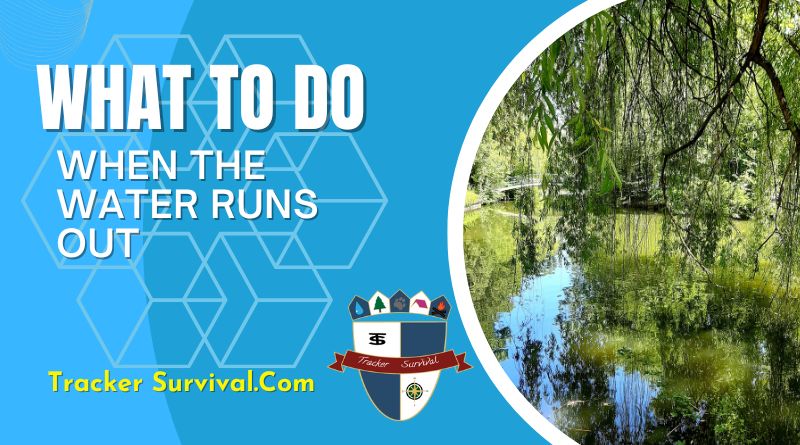
What To Do When The Taps Run Dry
If your water supply has stopped for whatever reason. Immediately start rationing water. Water is one of the things we take for granted as always being readily available. Most people don’t realize how much water they waste daily. Simple things like brushing teeth with the water still running wastes gallons of water. When the taps stop running and you have no idea when the water will be turned back on. Ration, ration, and ration some more. People are surprised how much water they can cut back on if they try really hard.
How To Source Drinking Water In An Emergency
When it seems that all avenues of finding water have run out, there are still ways to squeeze the last drop of water from the surrounding area.
Plant Stills
Clear plastic bags, a small stone, cordage, and plants are all that is needed. Place the stone in a corner of the plastic bag. Then place it over the hanging plant. Tie the top of the plastic bag as tightly as possible. As the sun heats up the plant, it will release moisture which will accumulate at the bottom of the bag where the stone is. Make 100% sure that the plant you are attempting to get water from is not poisonous.
Ground Solar Stills
Dig a pit about 3 to 4 feet wide and 2 feet deep in direct sunlight. Place a layer of green foliage in the pit. Place a rock in the center of the pit and a container on the rock. Cover the pit with a plastic sheet. Pack soil around the edges to try and make it as airtight as possible. On top of the sheet place a small stone, right above the container. The sun will heat the pit and moisture from the ground and foliage in the pit will accumulate underneath the plastic. It will then roll down to the lowest point, which should be the stone right above the container.
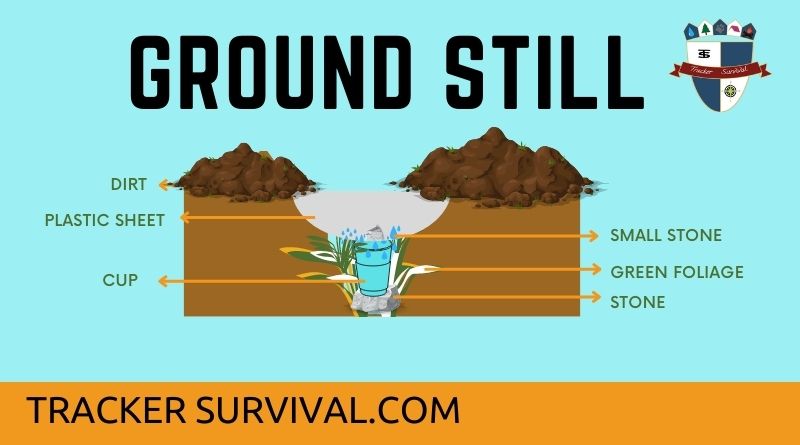
Making Seawater Potable
Being stranded on a coastline and dying of thirst surrounded by seawater is a terrible way to go. But with a little bit of know how and some very basic gear. There are ways to distill seawater to make it potable.
Fire-Based Distillation Method
Put seawater in a container and boil over a fire, hang a piece of material over the pot when the material is soaked through, squeeze the water into another container. Or if a waterproof material is available, funnel the steam directedly into another container.
Solar Based Distillation Method
Dig a shallow pit, in the center lay some stones or wood. Place a container on the stones/wood and cover it with a sheet of plastic. Place a small pebble on top of the plastic right above where the container in the pit is. As the sun evaporates the seawater, the condensation rises and collects underneath the plastic sheet. It will then roll down to the lowest point which should be underneath the pebble above the container. This is the same principle as a solar still, instead of moisture from the ground. It is condensation from seawater.
Collect Rain Water
Collecting rainwater is one of the easiest sources of sustainable water. And has been done by humans for hundreds of years. Depending on the area of course.
Collect rainwater from roof gutters, and put any empty containers outside, such as buckets, children’s inflatable pools, tarps, plastic sheets, or any material you can find to funnel water into a container.
There are dozens of methods of collecting rainwater, for residential homes the most popular and simplest is just placing a barrel or drum under the downspout of the homes roof gutter.
Processing, Filtering, And Making Potable Water
To be on the safe side, ALL water needs to be treated before drinking, even if the water appears crystal clear it could be packed full of pathogens. There are various methods of processing water to make it fit for human consumption. Not one single of these methods is 100% foolproof against all possible contaminants.
For example, some survival water filters cannot filter out viruses, saltwater, or chemical agents.
Boiling water does not make chemically contaminated water safe and cannot remove salt from water.
Water purification tablets do not work on salt water or chemically contaminated water.
DIY Water Filter
If no other methods are available, nature can provide a makeshift water filter.
Cut the bottom off a plastic bottle, a 2-liter bottle would be perfect, but any medium to large-sized bottle will do.
Poke a half-cm-sized hole in the bottle cap. “If the hole is too small, gently unscrew the cap, remove it from the bottle and make the hole bigger. Be careful that the contents of the bottle do not flow out.”
Place a coffee filter firmly wedged on the inside of the bottleneck, if there are no coffee filters available, use cotton balls or a piece of clean material.
Getting some charcoal, from your fireplace is fine. But make sure to brush off the ash first. Ashes have no filtering properties and they will make the water taste terrible. Crush the charcoal and place about 1 and a half to 2 inches in the bottle.
Now it is time to start layering material to filter out particles from the water. At least 1 inch of each, fine sand, then coarse sand, then small gravel, and finally larger gravel.
Fill the bottle with water and let it slowly drip out. Filtering the water more than once does no harm and if possible, boil the water after filtering.
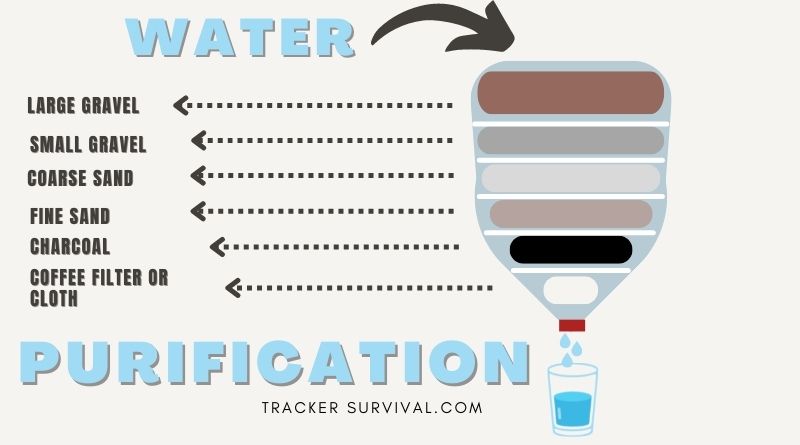
Bleach To Disinfect Water
If boiling water is not an option, using unscented chlorine bleach to disinfect water is possible. The exact measurements are listed on the EPA.GOV website linked HERE
Survival Water Filters
Making potable water in an emergency is quick and easy. These little gems are fantastic. Right up there on the list of always pack in a bug-out bag. Every member of a family should have one of these. It cannot be stressed how convenient these things are. For more information on Survival Water Filters check out this post Water Purification in a survival situation.
Water Purification Tablets
Water purification tablets most commonly contain chlorine dioxide, chlorine, or iodine. These chemicals are quite effective at dealing with viruses and bacteria.
Reference:
70% Earth Surface Water
1.2% Drinking Water
Waterborne Bacteria and Viruses